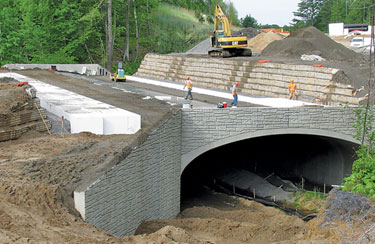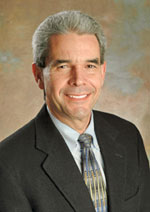
adam.bruns bounce@conway.com
n the beginning, there was the soil. There was a whole lot of water, plenty of power and all kinds of infrastructure, built to the highest standard. There was even a project, a planned billion-dollar chip fab from AMD. But it languished.
In the end, there was a new beginning, as AMD spinoff GlobalFoundries, supported by Middle East investors, in June finalized its purchase of 223 acres (90 hectares) at the 1,414-acre (572-hectare) Luther Forest Technology Campus in Malta, N.Y., and shortly thereafter started moving dirt for its US$4.2-billion semiconductor manufacturing facility.
That’s $1 billion more than the AMD project, when it was originally announced back in June 2006.

The job total has inched higher too, from 1,200 to 1,400. The original project was to receive $1.2 billion in incentives from the State of New York. The state’s commitment, even in tough times, stands firm, divided between $650 million in outright cash and $550 million in tax breaks.
“It was three years ago this month that we announced plans to build and operate the most advanced semiconductor manufacturing facility in the world in upstate New York,” said Hector Ruiz, chairman, GlobalFoundries, and former president and CEO of AMD. “Over the course of that time we have worked hard to develop this project while reinventing our overall business strategy and ultimately launching GlobalFoundries as a new company. Along the way we have had tremendous support from the people of New York and it is with great pleasure that today we announce our official commitment and the start of the construction phase of this exciting project.”
“New York is in position to lead the nation in the New Economy,” said Gov. David Paterson, who found himself exulting in a similar investment from IBM not long ago. “This project represents exactly the type of innovation and cutting-edge technology that will give our state a critical advantage moving forward. It is also the largest public-private sector industrial investment in New York State history, with thousands of new jobs and billions of dollars in capital expenditures, which will have an incredible impact.”
That impact extends even beyond the state line to places such as the Tech Valley region of the Berkshires in Massachusetts, where GlobalFoundries Director of Public Affairs Travis Bullard recently informed residents of opportunities related to the project.
Among the formalities cinched in June was the completion of the development agreement with the Town of Malta and the Town of Stillwater, which calls for the company to contribute $1 million towards the creation of a public recreation field complex and $4 million to establish two independent foundations designed to provide dedicated funding for future community enrichment programs in each town.?The firm also authorized Germany-based high-tech design and construction firm M+W Zander to award site development work, with clearing and grubbing work beginning on June 15. The final complex, due to be in full production by 2012, will include 1.3 million gross sq. ft. (120,770 sq. m.) of space, featuring 270,000 sq. ft. (25,083 sq. m.) of class 100 clean-room space.
The reinvention Ruiz spoke of came thanks to Advanced Technology Investment Co. (ATIC) of Abu Dhabi, which came to AMD’s rescue and helped form the new company in October 2008. Wholly owned by the Emirate of Abu Dhabi, ATIC is dedicated to making significant investments in advanced technology at home and internationally, with the mandate to “generate returns that deliver long-term benefits to the Emirate of Abu Dhabi.” ATIC is headed by Chairman Waleed Ahmed Al Mokarrab Al Muhairi, a Harvard-educated former industrial and government project consultant for McKinsey & Co., who also serves as COO of the Mubadala Development Co. Among the advantages ATIC claims as an investor are “significant and reliable capital, a patient investment philosophy, and a subsequently long-term investment horizon.”
That’s good, because patience has been the order of the day in the Upstate. Then again, so has nanoelectronic expertise. Michael Relyea, president of Luther Forest Technology Campus Economic Development Corp., describes the journey.
“Two years ago when I came on board, not much of the project had changed,” he says, though infrastructure development continued. Then a call came from the company team saying they had a firm date in mind. That set things in more determined motion, as months of work went into hundreds of document pages firming up development agreements and permits with the towns. Among LFTC’s partners are the Saratoga Economic Development Corporation, the Saratoga County Board of Supervisors, and state government leaders.
“In October, around the time the fiscal crisis hit, they felt it was important for them to come out and announce how they were going to move forward as a company,” says Relyea of AMD’s spinoff of GlobalFoundries. “Hector Ruiz had told me at dinner one time, ‘We are going to do something that’s going to shake this place up.’ There was a lot of skepticism up here. People weren’t sure how to handle the investors coming from the UAE. So there was an education process we went through. As a result of that, people understood that this new plant was going to be a whole lot better.”
That’s not just because of the deep pockets in Abu Dhabi. It also owes to a change in focus for the Luther Forest campus as a whole.
“Instead of having a foundry dedicated to a specific company, it’s dedicated to an industry,” says Relyea. “That got everyone’s attention, thinking out of the box, and realizing that we might have something bigger here in terms of overall ability to build out our park as well as the region.”
That region’s assets include the College of Nanoscale Science and Engineering of the University at Albany, which in late May held a job fair to assist M+W Zander in recruiting applicants for 40 new positions related to the new foundry.
GlobalFoundries has purchased enough land to build three fabs, with pre-zoning in place that would compress the site plan review process into 90 days. Two of the nine large areas yet to be developed at Luther Forest have been pre-approved for large-scale semiconductor and nanotechnology manufacturing. Relyea says his team is aiming for a “rock star” campus, with “massive” infrastructure from water (15 million gallons a day) to sewer to roads that, from the beginning, was directed to be constructed at the highest standard. That’s so “we can accept the top standard, and get everything underneath it,” in project recruitment, he says.
Among the massive infrastructure assets at the site that are beyond any earthly being’s control is the earth itself. Specifically, the alluvial soil, left behind by glaciers. It’s just one of the attributes that puts Luther Forest in a unique position versus the many former semiconductor fab sites now being marketed around the country.
“We’re on glacial sand – no stone, no bedrock,” says Relyea. “I tell people that if you see a stone, pick it up, because that means someone brought it there. It allows us to construct things a lot faster than others.”
It also absorbs vibration, a top-shelf concern among electronics prospects. Not that there’s much vibration concern at Luther Forest: There’s no railroad nearby either, which would be a drawback for heavy industry but is a highlight for the high-tech, knowledge industries that this region seems poised to cultivate.

he headquarters relocation sweepstakes saw ample activity in spring 2009, with moves that caused consternation in spurned communities and not-so-muffled delight in those corporations’ new homes.
Things got started in April with power and automation technology firm ABB‘s relocation of its North American HQ from Norwalk, Conn., to Cary, N.C. Cary was selected over four other U.S. cities, said the company.
“ABB already has a significant and growing presence in the Raleigh-Cary metropolitan area in terms of proximity to some of our key customers, our employee base, and various divisional headquarters,” said Enrique Santacana, president and CEO of ABB in North America. “After a thorough analysis of economic trends, commercial property rates and other cities, it became clear that there were many advantages in moving our headquarters to Cary.” Commercial office property rates in Cary are close to 50 percent lower than in Norwalk.
The move will add about 100 jobs to a Triangle-area work force that already numbers about 500. ABB employs 900 in the state, including the ABB Human Resources Service Center and the ABB Shared Accounting Services Center established in 2008 in Cary.
In late May, kidney care provider DaVita announced it was moving its headquarters from El Segundo, Calif., to Denver, Colo. Senior executives will relocate, but “relocation efforts are not currently planned for teammates working in the current El Segundo, California headquarters or elsewhere around the company,” said an official release.
Some have translated that statement as meaning all HQ positions in Denver will go to Denver-area residents. But Brad Chase, spokesman for DaVita, says it means “at this company, nobody would ever be forced to move.” It also means that the El Segundo office, currently staffed with 250 “teammates,” is not going anywhere. Chase says no further details have yet been ironed out with regard to timeline, specific location or job numbers in Denver.

“A lot of job growth will come in Denver over time,” he says, “but it’s hard to project how big the office will grow” and whether or not those positions will be filled by relocated teammates from other DaVita offices across the nation. The company has gone from the brink of bankruptcy a decade ago to a FORTUNE 500 company with $5.6 billion in operating revenues in 2008 and employing more than 32,000 today. Much of its growth has arisen organically from its network of more than 1,475 dialysis centers and more than 700 acute units at hospitals.
As with ABB, the winning city beat out four unnamed competitors. The company said the decision was driven by four factors: 1) the city’s ideal geographic location for a nationwide company with facilities and operations spread across nearly every state in the country; 2) the less expensive relative costs in the area for families and companies; 3) Denver’s reputation as a desirable place to live and work; and 4) DaVita’s existing presence in Colorado, which includes 30 outpatient facilities and nearly 800 employees in the state, 400 of them at a facility in the Denver suburb of Lakewood. The company expects to see millions of dollars in savings as a result of the move.
Some of those savings will be realized because of a newly passed law that DaVita CEO Kent Thiry called “essential” to the decision. For companies that create more than 20 jobs, House Bill 1001 provides an income tax credit equal to half the amount paid in federal Social Security and Medicare taxes on newly created jobs that pay at least 110 percent of a county’s average wage.
Perhaps the most earthshaking HQ move of the spring happened in June, when NCR Corp., which has been based in Dayton, Ohio, for generations, said it would move its entire corporate headquarters to the Atlanta suburb of Duluth, Ga., bringing 1,300 jobs south. The move follows the company’s October 2008 creation of an Atlanta-area customer service center of excellence that was to create 916 jobs by the end of 2010.
Accompanying the relocation is a new ATM manufacturing and R&D complex in the former Panasonic building in Columbus, Ga., 100 miles (161 km.) southwest of Atlanta, creating another 870 jobs. More than 1,650 people showed up in mid-June to apply for the company’s first 88 positions at the plant, on the same day that NCR was announcing a parallel ATM manufacturing and R&D facility investment in Brazil.
Ohio Lt. Gov. Lee Fisher, who’s also running for a U.S. Senate seat, called a press conference at which he said NCR CEO Bill Nuti had acted “irresponsibly and shamefully,” and said the company had stonewalled the state after repeated attempts to negotiate business climate issues. A statement from NCR said such issues were discussed on repeated occasions with government officials.
Georgia’s incentive package includes an announced $60 million in subsidies. But records obtained by The Atlanta Journal-Constitution show other programs to be accessed by NCR will bring the total to around $109 million, once incentives such as state grants put into play via local communities are counted.
Site Selection Online – The magazine of Corporate Real Estate Strategy and Area Economic Development.
©2009 Conway Data, Inc. All rights reserved. SiteNet data is from many sources and not warranted to be accurate or current.